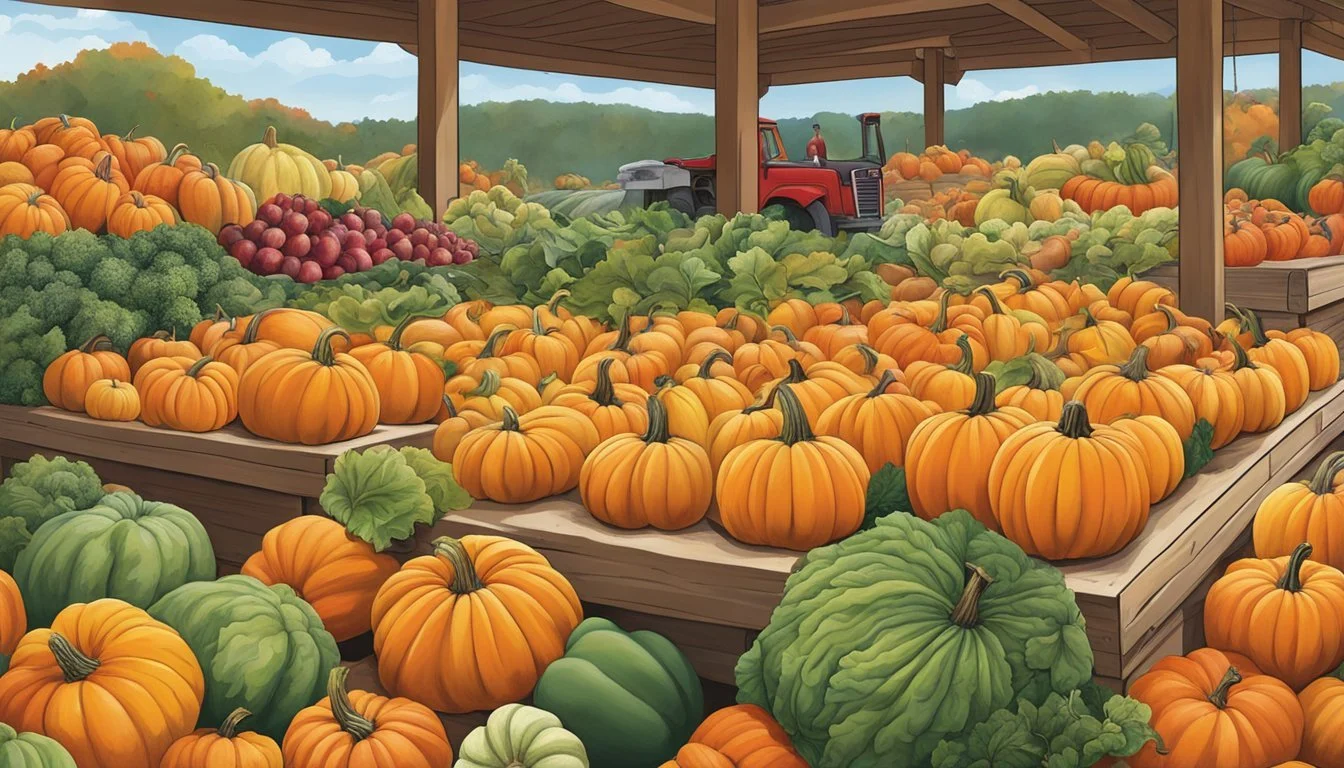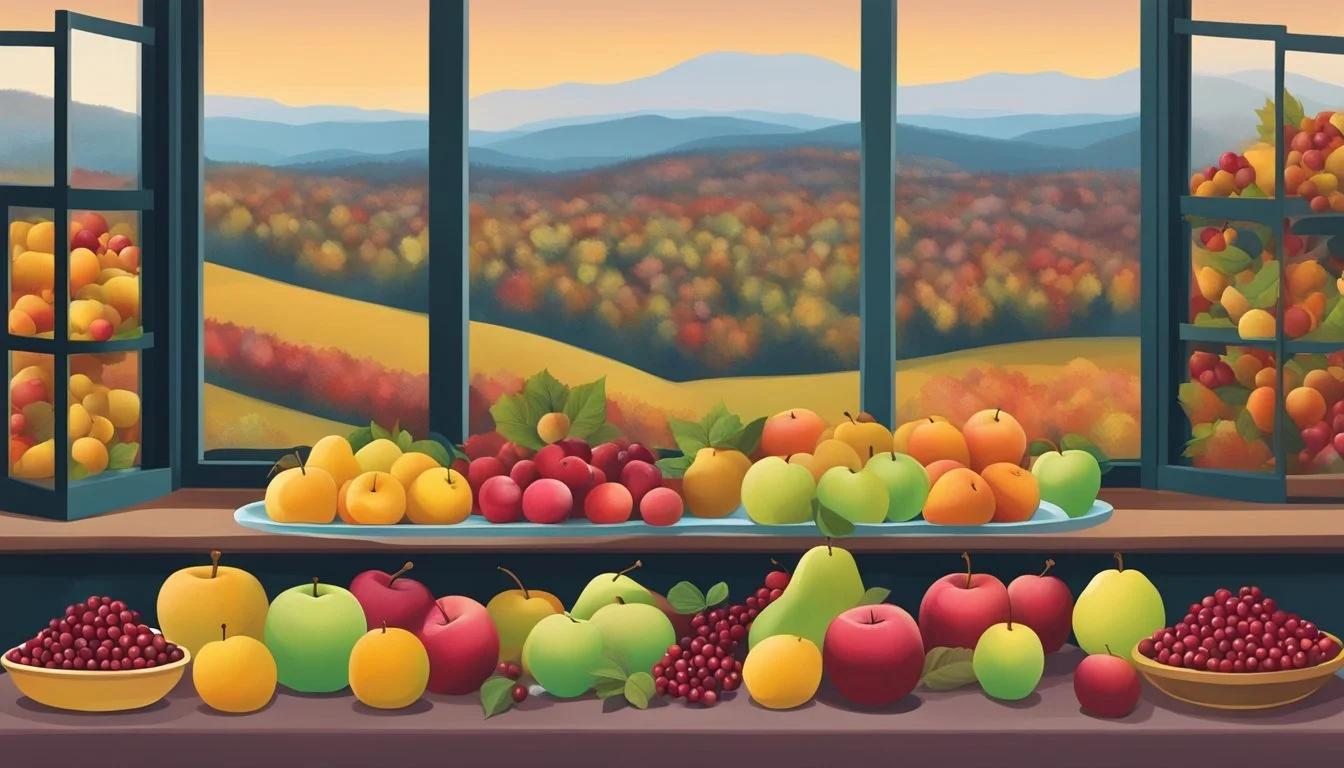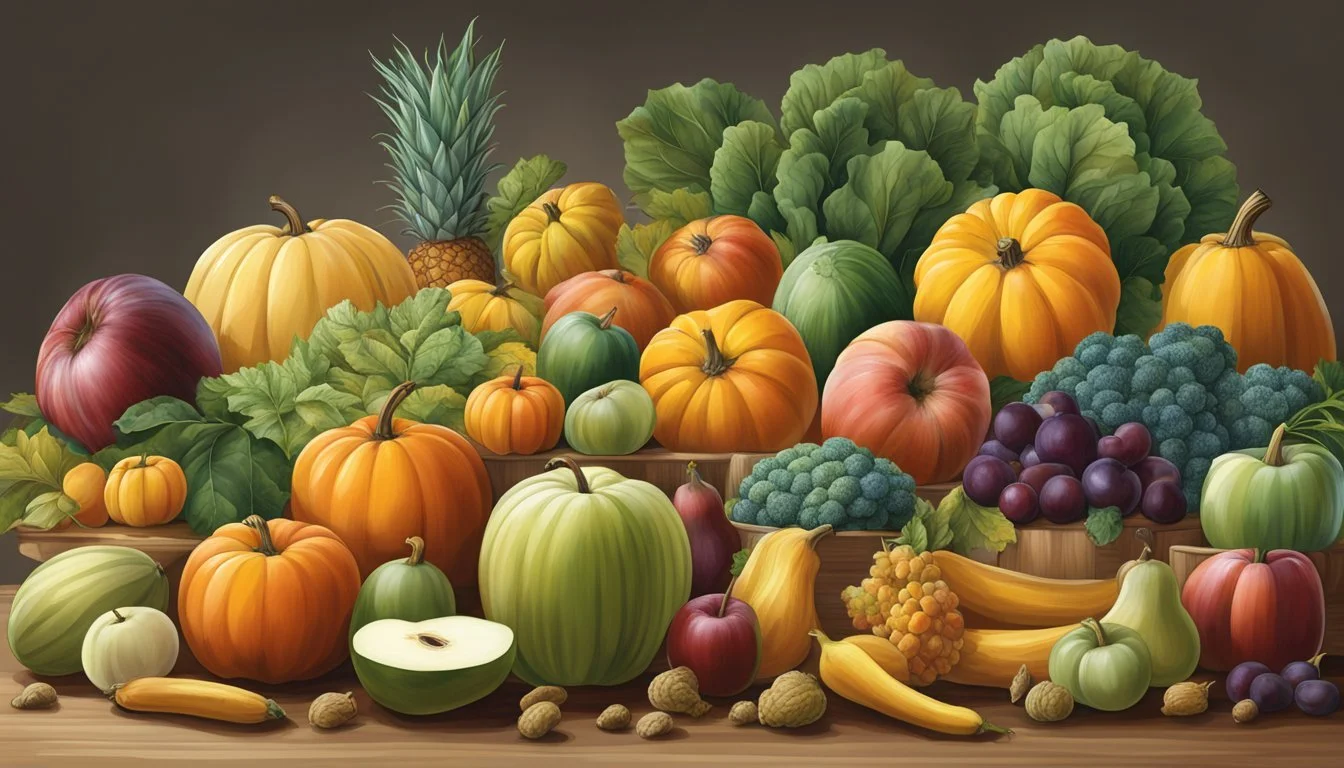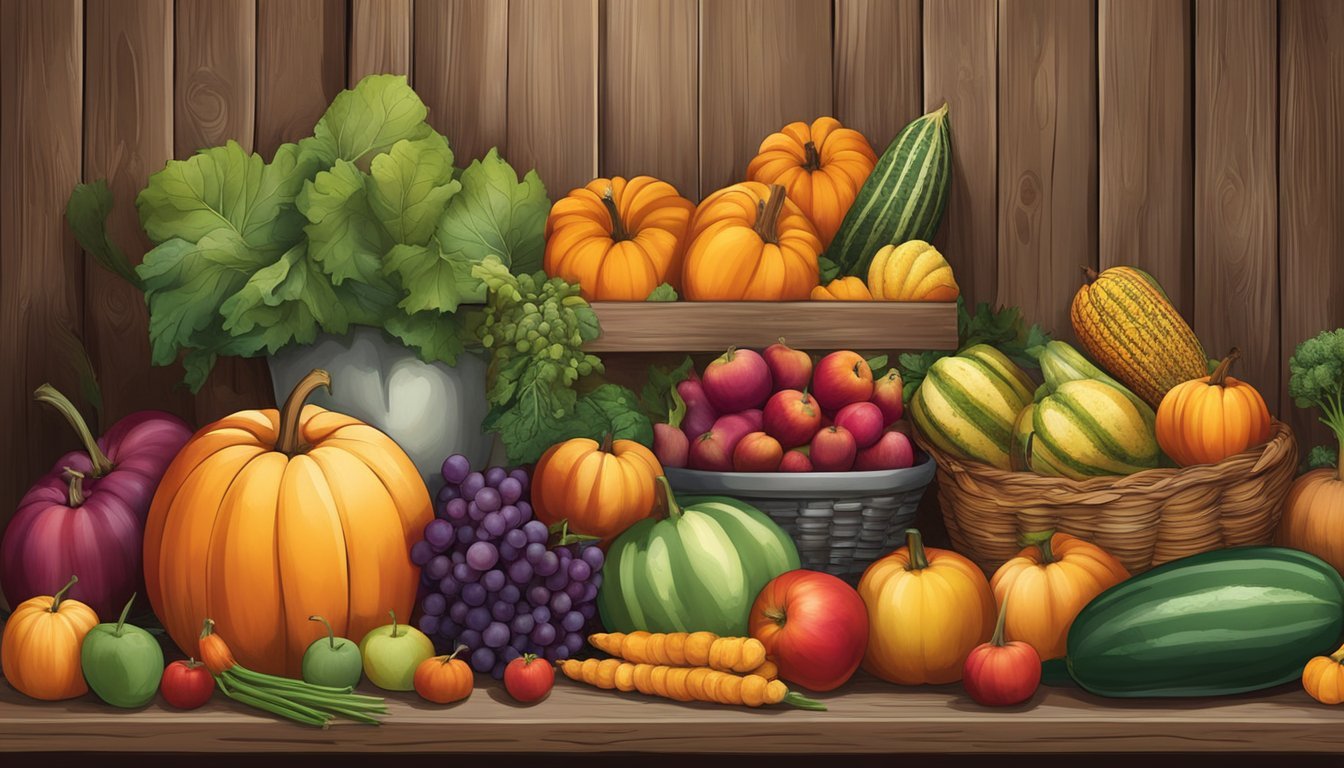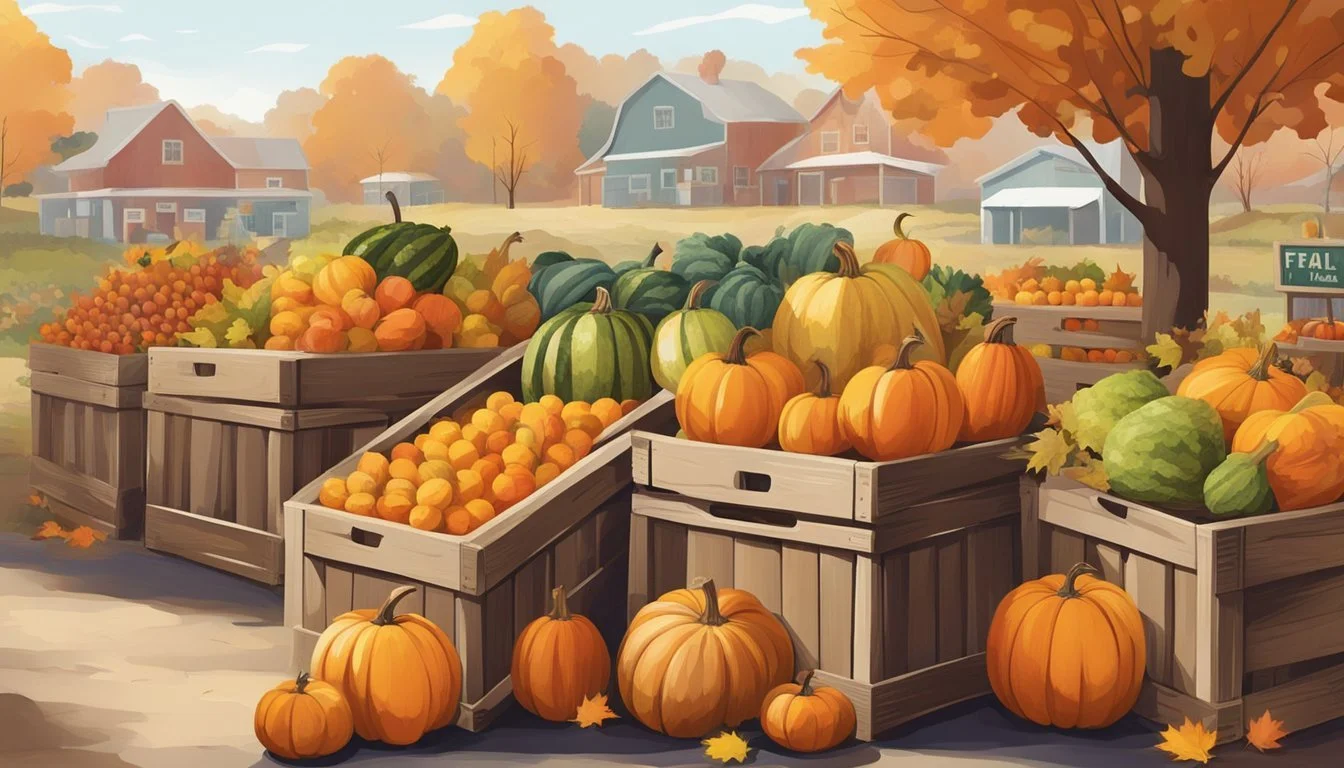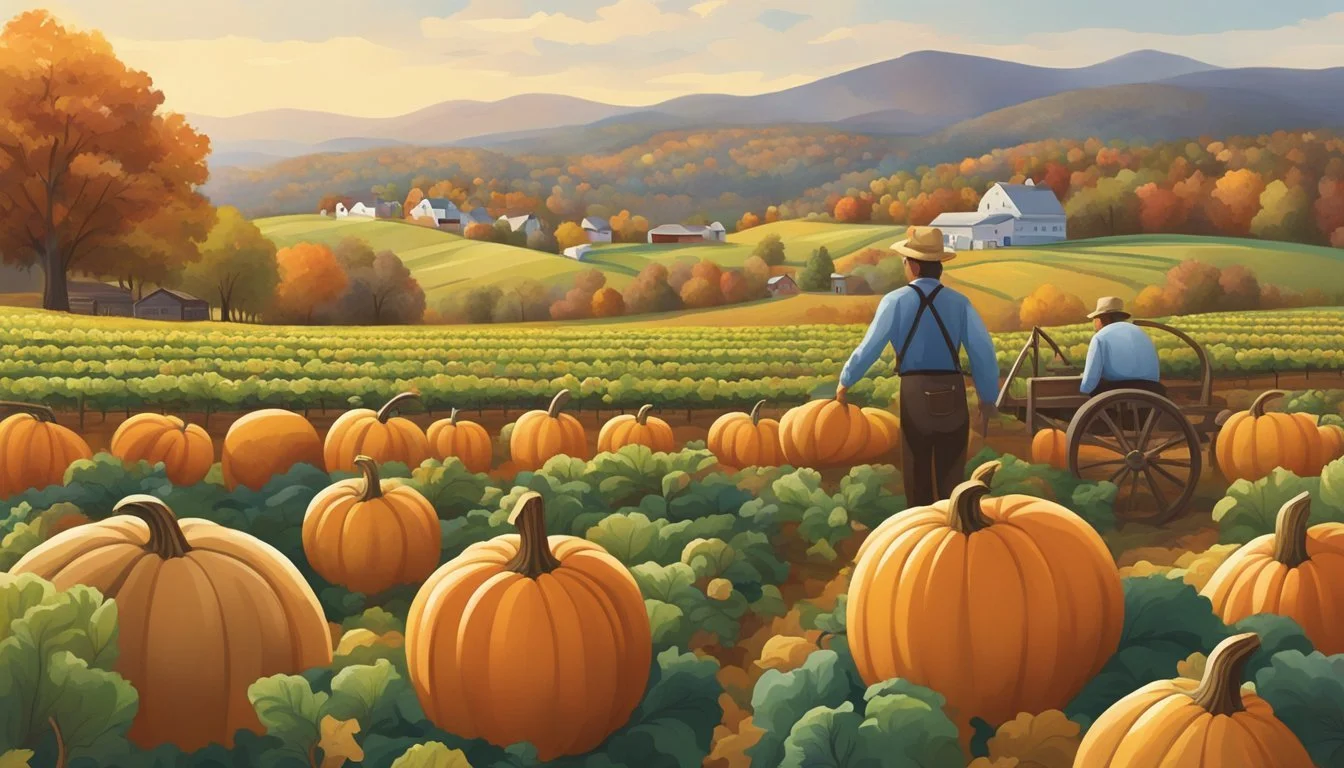West Virginia Seasonal Fruit & Vegetables in November
Your Guide to Fresh Produce
This Article is Part of our West Virginia Seasonal Fruit & Veg Calendar
November in West Virginia marks a transitional period in the agricultural calendar, a time when the vivid colors of fall harvest give way to the more subdued hues of winter crops. The state's varied terrain and climate contribute to a distinct selection of fruits and vegetables that are harvested during this month. Local markets are typically stocked with late-season produce that is well-suited to the cooling temperatures.
Among the offerings, root vegetables such as beets and carrots thrive in the colder weather, storing energy in their roots and offering a sweet, earthy flavor that is ideal for hearty stews and roasts. Leafy greens like spinach may also be available, benefiting from the frost that can enhance their sweetness. Meanwhile, winter squashes, including varieties like acorn and butternut, are at their peak, providing a versatile ingredient for both savory dishes and desserts. These seasonal fruits and vegetables embody the regional characteristics of West Virginia's agriculture, emphasizing the importance of eating locally and seasonally.
Seasonal Overview of West Virginia Produce
In November, West Virginia’s autumnal harvest continues to offer a bounty of fresh produce to its residents. During this month, root vegetables and hearty greens typically thrive, reflecting the shift towards cooler weather.
Fruits:
Apples remain a seasonal highlight, with many varieties reaching their peak.
Pears are also readily available, offering a sweet addition to fall recipes.
Vegetables:
Squash varieties such as butternut, acorn, and spaghetti squash are abundant, perfect for warm, comforting dishes.
Leafy greens like kale (What wine goes well with kale?) and collards withstand the chill, providing rich nutrients.
Root vegetables, including sweet potatoes, carrots, and turnips, are in ample supply and ideal for roasting or stews.
Farmers in West Virginia take great pride in their late-season crops, ensuring that produce like pumpkins and gourds remain available for culinary and decorative uses.
Consumers favoring local and fresh ingredients will find that November's offerings embrace the essence of fall, making it an ideal time for preparing seasonally inspired meals. As the temperatures drop, the state’s produce selection showcases the resilience and variety inherent to West Virginia’s agricultural landscape.
Fruits Available in November
November in West Virginia offers a limited but delicious variety of fruits that thrive in the late autumn season. Fruit enthusiasts can savor the last fresh picks from local orchards and farms before the winter sets in.
Tree Fruits
In November, tree fruits see the tail end of their season, but a selection remains available for harvest.
Apples: A cornerstone of November's fruit bounty, available varieties may include crisp and tart options perfect for both eating fresh and using in Thanksgiving recipes.
Pears: These fruits often reach the peak of their sweetness in the late fall, making them an enjoyable fresh snack and a flavorful addition to seasonal dishes.
Vine and Bush Fruits
The cooler temperatures of November generally mark the end of the season for vine and bush fruits, yet some can still be found.
Cranberries: While not as commonly grown in West Virginia as apples and pears, cranberries harvested in this month are typically at their best, rich in flavor and ideal for holiday cranberry sauces and other festive dishes.
For those looking to enjoy seasonal fruit from West Virginia, November's selection, while narrower than the summer months, provides robust flavors and ample opportunities for seasonal recipes and holiday feasts.
Vegetables Harvested in November
In November, West Virginia’s harvest offers a rich variety of vegetables that thrive in cooler weather, including a bounty of cruciferous vegetables, hearty root vegetables, and an array of leafy greens.
Cruciferous Vegetables
Brussels Sprouts (how long do brussels sprouts last?): These small, cabbage-like vegetables are harvested in November. They are known for their slightly nutty flavor and are commonly roasted or steamed.
Cabbage: A staple in many dishes, cabbage is versatile, and its harvesting peaks in the cool month of November.
Kale: A nutrient-dense leafy green, kale is at its best this month, often sweeter after a light frost.
Root Vegetables
Carrots: With their natural sweetness, carrots harvested in November are often particularly flavorful.
Beets: Deep in color and rich in taste, beets are in their prime and offer both culinary versatility and nutritional benefits.
Turnips: Harvested in November, turnips can be used in a variety of dishes, from roasts to stews.
Radishes: Crisp and peppery, radishes add a fresh bite to salads and side dishes.
Potatoes: A hearty staple, potatoes harvested this month are excellent for a variety of comforting, cold-weather recipes.
Leafy Greens
Spinach: This tender green is ideal for salads and can also be cooked for a warm side dish.
Arugula: With its peppery profile, arugula harvested in November is great for adding a kick to salads and sandwiches.
Chard: Chard offers vibrant color and a slightly earthy taste, perfect for sautéing or adding to soups.
Lettuce: Various types of lettuce are also gathered in November, providing the foundation for many types of fresh salads.
Choosing and Storing November Produce
In November, one finds a variety of fruits and vegetables in West Virginia that are both rich in flavor and nutrients. For instance, acorn squash, renowned for its sweet, buttery taste, is abundant. To ensure maximum freshness and retain vitamin A, it should be stored in a cool, dark place.
Storing Squash:
Uncooked: Place in a cool, dark environment like a pantry for up to 1-3 months.
Cooked: Seal cut pieces in airtight plastic wrap; refrigerate and use within 5 days.
Sweet potatoes and cranberries are also in season; these are not only flavorful but densely packed with vitamins.
Storing Sweet Potatoes & Cranberries:
Sweet potatoes: Store in a dark, well-ventilated area. They can last up to a month if kept away from moisture.
Cranberries: Keep in the refrigerator in a sealed container; they’ll stay fresh for about 3-4 weeks.
When selecting fresh produce in November, one should look for firmness and a vibrant color indicative of ripeness and nutrient content.
Choosing Fresh Fruit:
Apples: Look for firm fruits with no soft spots. They can be stored in a fridge for several weeks.
Pears: Choose ones that are firm. Store at room temperature until ripe, then refrigerate.
By following these guidelines, individuals can enjoy the seasonal produce of West Virginia while ensuring optimal taste and nutritional value.
Culinary Applications and Recipes
In November, West Virginia's bounty offers robust flavors perfect for hearty meals. Utilizing seasonal produce, chefs and home cooks alike can create dishes that are both nutritious and warming as the colder weather takes hold.
Roasted Vegetables: Root vegetables like beets, sweet potatoes, turnips, and rutabagas gain a sweet, caramelized flavor when roasted. They can serve as a side dish or be added to salads for a nutritious crunch. A simple recipe involves dicing the vegetables, tossing them with olive oil, salt, and pepper, and roasting at 400°F until tender.
Salads: Fresh seasonal produce shines in salads. For a twist, one might consider a warm salad featuring roasted root vegetables atop a bed of kale or spinach, tossed with a vinaigrette dressing.
Winter Squash: Varieties such as butternut or acorn squash are versatile and can be transformed into soups, purees, or stuffed with a savory filling. However, they can also be used in sweet recipes like pies or cakes, providing a natural sweetness and moist texture.
Soup: A recipe for butternut squash (how long does butternut squash last?) soup might include the squash, vegetable stock, onions, garlic, and herbs like thyme or sage, all blended together to create a smooth, velvety winter soup.
Stuffed Squash: Acorn squash halves can be filled with a mixture of quinoa, cranberries, nuts, and spices, then roasted until the squash is tender.
These applications not only highlight the flavor profiles of November's seasonal produce but also provide creativity and variety in the kitchen. They invite a celebration of local, seasonal food that is at the heart of West Virginia's culinary scene.
Health Benefits of Seasonal Eating
Consuming seasonal fruits and vegetables offers various health benefits. When individuals choose seasonal produce, they often enjoy fruits and vegetables that are harvested at their peak ripeness. This means that the produce is not only more flavorful but also typically more nutrient-dense.
Nutrient Density: Seasonal fruits tend to have higher nutrient levels. For example, vitamin A, which is essential for eye health and immune function, is abundant in many seasonal fruits. By including a variety of these fruits in their diet, consumers can enhance their intake of this important nutrient.
Vitamin A Sources:
Sweet Potatoes
Carrots
Kale
Spinach
The act of eating in harmony with the seasons also encourages a diverse diet. This variety is beneficial because it provides the body with a wide array of nutrients over the course of the year.
Advantages of Seasonal Eating:
Freshness and Flavor: Seasonal produce is often fresher, tastier, and perfectly ripe.
Nutrient Diversity: Different seasons bring different fruits and vegetables, promoting a varied diet.
Supports Immunity: Vitamin-rich seasonal produce can boost the immune system.
Including seasonal fruits in November, such as apples and pears from West Virginia, can be an excellent way to capitalize on these benefits. They not only provide an opportunity to enjoy fresh, local produce but also offer a wealth of nutrients that are crucial for maintaining health during the transition into winter months.
Local Markets and Seasonal Availability
As November arrives in West Virginia, local markets and grocery stores adjust their offerings to align with the seasonal crops that are available. Shoppers can expect a shift to autumnal produce, with both farmers markets and grocery stores featuring a variety of locally sourced fruits and vegetables.
Farmers Markets
Farmers markets in West Virginia become hubs for late autumn produce during November. Seasonal availability is shaped by the state's harvest calendar, with markets often showcasing:
Apples: A staple of the season, with various types still available.
Pears: Likely to be found as they are harvested through October.
Squash: Varieties such as acorn, and butternut squash are prevalent.
Pumpkins: Remaining stock from October can still be found, ideal for pie-making and seasonal recipes.
Root Vegetables: Expect to see carrots, turnips, and potatoes.
These markets are typically operated by the local farming community, ensuring that the produce is fresh and of high quality. It is common for farmers to offer a selection of value-added products like jams, preserves, and cider that complement the seasonal produce.
Grocery Stores
Grocery stores in West Virginia also participate in promoting locally grown products. During November, many grocery stores will source from local farms wherever possible. Shoppers can find:
Late Harvest Vegetables: Including green beans, Brussels sprouts, and a variety of leafy greens which are generally still available in the early part of the month.
Local Dairy and Meats: Many stores pair produce with other local goods, supporting a full farm-to-table experience.
Accessibility to these local products in grocery stores is often made possible through community-supported agriculture programs (CSAs) or direct partnerships with area farms. This not only supports the state's agricultural economy but also encourages a sustainable food system.
Agricultural Practices in West Virginia
In West Virginia, agriculture contributes significantly to the state's economy, with family-owned farms making up about 95 percent of the farming community. These farms are distributed across the state and deliver a variety of crops directly to consumers through farmers' markets, supermarkets, and farm stands. The commitment to family-based agriculture underlines the state's dedication to sustainable and locally-oriented farming practices.
Key Crops:
Fruits: Apples, peaches, berries
Vegetables: Tomatoes, peppers, greens
Others: Corn, hay (for livestock), and nursery products
West Virginia's topography and climate influence what can be grown and when, leading to a focus on seasonal produce. The state's farmers utilize both traditional and modern farming methods to optimize production and ensure the quality of their produce remains high. Rotation of crops is a common practice to maintain soil health, and many farms also integrate livestock to create a balanced agricultural ecosystem.
Extension Services: The West Virginia University (WVU) Extension Service plays a pivotal role in supporting agricultural practices through education and resources. They distribute a Garden Calendar each year to aid farmers and gardeners with seasonal planting schedules and provide a variety of programs and outreach efforts to enhance farming techniques statewide.
Farmers in West Virginia must comply with regulatory practices, particularly when food safety is concerned, to mitigate risks such as Salmonella outbreaks. This includes crop management and following inspection protocols provided by the state's Department of Agriculture when necessary.
The continued growth of agriculture in West Virginia is not just seen in the volume of crops produced but in the quality and diversity. As the industry evolves, the state is seen as holding promise for increased agricultural prosperity.
Environmental Impact of Seasonal Consumption
Consuming seasonal fruits and vegetables can significantly influence the local environment in West Virginia. When residents purchase food that aligns with the natural growing seasons, it leads to a reduction in transportation distances. Local produce has a shorter journey from farm to table, resulting in less fuel consumption and lower greenhouse gas emissions.
Monoculture—the agricultural practice of growing a single crop over a wide area for a prolonged period—can diminish biodiversity. Seasonal consumption helps to avoid this by supporting a rotation scheme where different crops are planted in different seasons, aiding in soil recovery and the preservation of local flora and fauna.
The table below highlights the key environmental benefits of seasonal consumption:
Benefit Description Reduced Transportation Shorter distance reduces carbon footprint. Lower Energy Usage Less refrigeration and storage needed for local produce. Biodiversity Support Crop rotation encourages a diverse ecosystem. Sustainability Seasonal foods often require fewer resources to grow.
In West Virginia, the seasonal availability of certain produce such as pumpkins, squash, and apples in November prompts less dependency on foods that must be transported from far regions. This local preference can also stimulate regional economies, as consumer spending is channeled back into community businesses rather than out-of-state or international operations.
Overall, seasonal consumption embodies an environmentally friendly approach that stands to benefit both nature and society. It promotes resource efficiency, supports local ecosystems, and diminishes the adverse impacts of long-distance food transport.
Food Community and Events
In West Virginia, November is a time when the community engages in various events celebrating the season's harvest. The state's agrarian roots are reflected in these gatherings, which emphasize local produce and community spirit.
Farmers Markets: Farmers markets are quintessential to West Virginia's food community in November. These markets often feature seasonal produce like acorn squash and an array of local goods. They not only serve as a place to purchase fresh, organic produce but also as a venue for locals to connect with farmers and artisans.
Harvest Festivals: November also sees numerous harvest festivals throughout West Virginia. These festivals celebrate the end of the growing season with a focus on food, crafts, and live entertainment. These events are central to West Virginia's community, fostering a sense of unity and appreciation for local harvest.
Community Dinners: Local communities come together to share in farm-to-table dinners, which often feature seasonal vegetables such as squash varieties. These communal meals strengthen community ties and showcase the best of local cuisine.
Agricultural Workshops: To share knowledge and cultivate a sense of togetherness around farming practices, various organizations host workshops and educational events during this month. These may include canning classes or sessions on sustainable agriculture.
Here is an example of a recurring event:
Wardensville Garden Market: An organic farm that offers more than fresh produce; it's a learning experience for local high school students, and a place for the community to access locally-sourced meat and bakery items.
Each of these events contributes significantly to the community fabric of West Virginia, reinforcing the importance of seasonal eating and supporting the local economy.


